Did you know there are about 1000 types of Anthurium plants? They are part of the Araceae family and are also known as Flamingo Flowers or Painted Tongue Plants. With so many varieties, Anthuriums can be tricky to care for. This guide will give you expert advice on fixing common Anthurium plant problems. We’ll help you grow beautiful and healthy plants at home or in your garden.
Key Takeaways
- Anthurium plants are prone to problems like overwatering, nutrient shortages, and pests.
- It’s important to get watering, lighting, soil, and fertilizing right for healthy Anthuriums.
- Watch out for yellow leaves, brown spathes, no blooms, and diseases caused by bacteria or fungi.
- Getting expert advice and tips can help solve Anthurium plant issues.
- Anthurium Scherzerianum is a type that does well in dry air.
Introduction to Anthurium Plant Care
Anthurium is a favorite among plant lovers. These tropical plants come from places like Colombia, Ecuador, Peru, and Brazil. They have around 1,000 species, making them the biggest group in the aroid family.
Family and Botanical Names
Anthuriums are also known as Anthurium andraeanum, Anthurium fruffles, and Anthurium plowmanii. Their unique look and easy care make them great for both inside and outside.
Growing Conditions
Anthurium plants love warm, tropical places. They grow on other plants or in rich soil. This makes them easy to care for indoors.
They are also great at cleaning the air. They remove harmful substances like formaldehyde and ammonia, as NASA suggests for indoor spaces.
“Anthurium plants are highly effective at removing formaldehyde, ammonia, toluene, and xylene from the air, making them good air-purifying houseplants.”
Anthurium plants come in many colors, like reds, pinks, greens, and whites. They add beauty to any space. Whether you’re an expert or new to gardening, learning how to care for these plants can help you grow a beautiful collection.
Potting and Lighting Requirements
Getting the right potting medium and lighting is key for your anthurium plant’s health. By focusing on these areas, you can help your anthurium thrive and enjoy its beautiful flowers for a long time.
Potting and Sunlight
For anthurium potting, use a soil mix that drains well. It should be based on peat moss or coco coir. This kind of anthurium soil keeps the right moisture and air around the roots. You should repot your anthurium when it gets too big or once a year to give it room to grow.
When it comes to anthurium lighting, these plants love bright, indirect sunlight. Place your anthurium about 3 feet from a window that faces the south. This gives it 6 hours or more of light each day. But, don’t put it in direct sunlight because it can burn the leaves and flowers. Light that is consistent and not too strong helps your anthurium grow and bloom well.
“Anthuriums require bright but indirect sunlight for optimal growth and flowering.”
If you’re using artificial light, like LED grow lights, make sure they have blue and red wavelengths. Use them for at least 12 hours a day. The right anthurium potting, anthurium soil, and lighting are essential for a healthy anthurium plant.
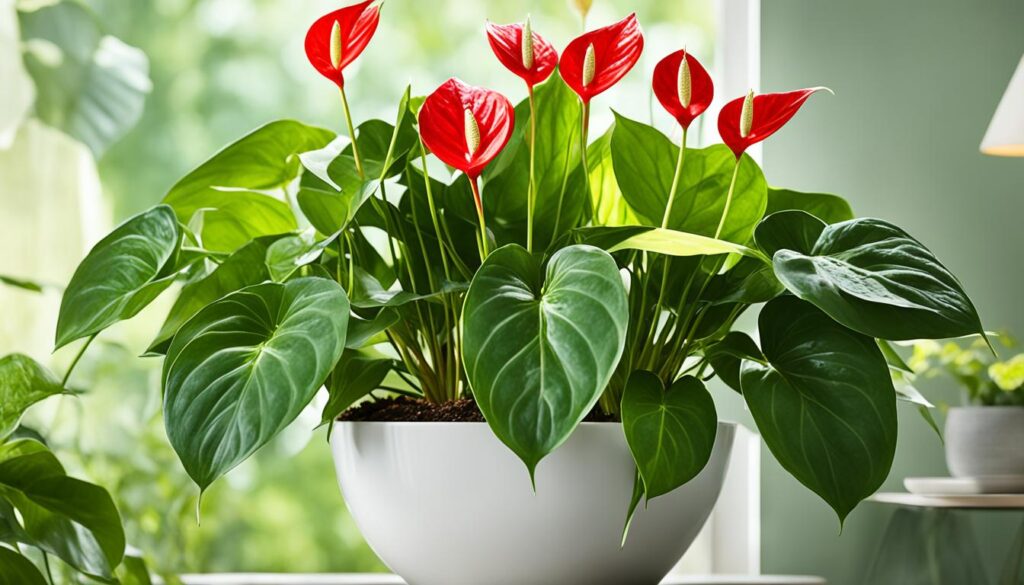
Watering and Soil Needs
Anthurium plants need special care with watering and soil. Getting these right is key to keeping them healthy and bright.
Watering
Water your anthurium when the top few inches of soil feel dry. But, don’t overdo it to avoid root rot. How often you water depends on the plant’s light and warmth.
During hot weather, water every 5 days. In the winter, you can go up to 10-14 days between waterings.
Soil Requirements
Anthuriums like soil that drains well to prevent root rot. A good mix includes wood chips, perlite, coarse sand, or pumice. This mix helps with drainage and keeps the soil from getting too wet or hard.
“Proper watering and soil selection are essential for the success of your anthurium plant.”
By following these tips on watering and soil, you’ll give your anthurium the best chance to flourish. You’ll enjoy its beautiful flowers for a long time.
Temperature, Humidity, and Fertilizing
Temperature and Humidity
Anthuriums love warm temperatures between 70-90°F. They can handle your home’s usual temperatures but stay away from cold below 50°F or too much heat. These plants need a lot of humidity, at least 50%, which is more than most homes have.
If your home is too dry, think about getting a humidifier. Or, put pebble-filled trays with water near your anthurium plants. Keeping the right temperature and humidity is key for their health and flowers.
Fertilising
Feed your anthurium once a month during the growing season with a ¼-strength liquid fertilizer. Don’t overdo it, as too much fertilizer can harm the roots and leaves. These plants grow slowly, adding about 4 inches tall each year, so they don’t need a lot of food.
Trim your anthurium to shape it as you like, considering its size and pot. Move it to a new pot every 2-3 years in winter, removing about 1/3 of the roots and using fresh potting soil. This helps with new root growth.
“Anthuriums are very susceptible to bacterial and fungal diseases that can seriously limit commercial production.”
Give your indoor anthurium the right anthurium temperature, anthurium humidity, and anthurium fertilizer. This way, your plant will do well and bloom beautifully.

Growth Rate, Size, and Pet Safety
Anthuriums are beautiful tropical houseplants that grow slowly but surely. They can grow about 4 inches tall each year. This means they rarely get taller than 30 inches, making them perfect for small spaces.
But, anthuriums can be dangerous for pets. They have parts that can make pets very sick if eaten. Pets may show signs like mouth pain, a lot of drooling, and trouble swallowing. In bad cases, they might vomit, have diarrhea, or even have seizures.
To keep pets safe, keep anthuriums away from them. You can put them on high shelves or in hanging baskets. Using sprays that pets don’t like can also help stop them from eating the plant. This way, you can still enjoy your anthuriums without risking your pets’ health.
“Even a small amount of anthurium ingestion can lead to harmful reactions in children, toddlers, and babies, emphasizing the need to keep the plant out of their reach.”
Anthuriums are great for indoor gardens because they grow slowly and don’t take up much space. But, we must be careful because they are toxic to pets. With the right care, we can enjoy these plants and keep our pets safe.
anthurium plant problems
Anthuriums are usually easy to care for but can face some issues. Knowing how to handle these problems helps keep your anthurium happy.
Overwatering and Underwatering
Proper watering is key for anthuriums. Too much water can cause root rot, while too little makes leaves wilt and the plant stressed. Water your anthurium when the top inch of soil feels dry. Use a potting mix that drains well.
Lighting Problems
Anthuriums need bright, indirect light. Too much direct sun can burn the leaves, and too little makes them stretch and reduces flowers. Place your anthurium where it gets several hours of bright, filtered light daily.
Pests and Diseases
Some pests and diseases can affect anthuriums, like spider mites, mealybugs, and bacterial blight. Check your plant often for pests or diseases. Act fast if you find any. Keeping your plant in good conditions and using clean tools can also prevent these issues.
Leaf and Flower Issues
Yellow or brown leaves and flower problems can signal various issues. The right care, including water, light, and nutrients, keeps your anthurium’s leaves and flowers looking great.
By tackling these common anthurium plant problems and anthurium troubleshooting methods, your anthurium can stay healthy and beautiful for many years.
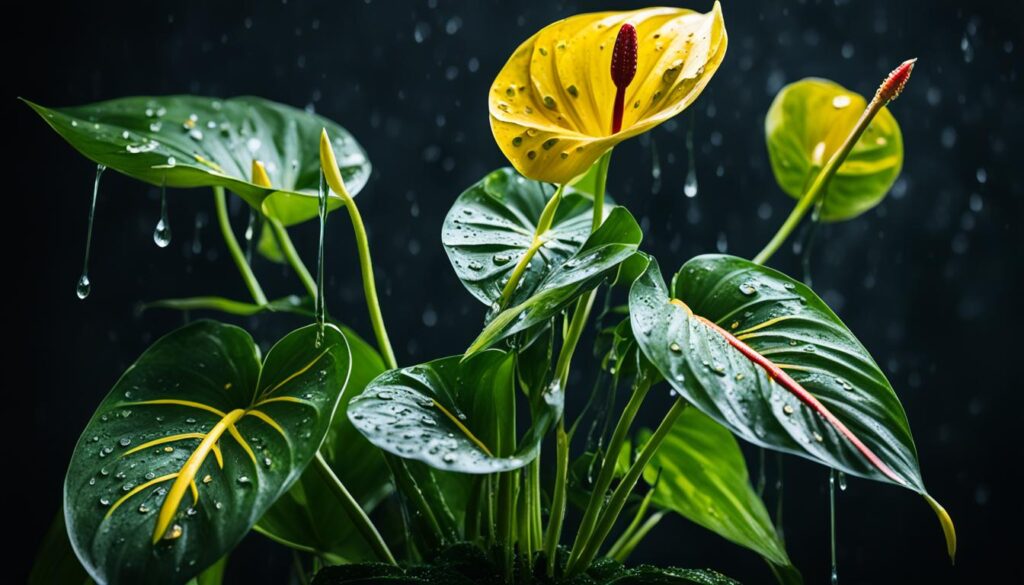
Overwatering and Underwatering
Proper watering is key for anthuriums. Both overwatering and underwatering can harm the plant. It’s important to know the signs and fix these issues to keep your anthurium healthy.
Overwatering often leads to anthurium root rot. Look for yellow leaves, a mushy feel, and leaves falling off. If the soil stays wet more than an inch deep, it’s too much water. This can cause diseases and hurt the roots.
But, not watering enough can also hurt your anthurium. Signs include droopy, brown leaves and slow growth. Make sure to water when the top inch of soil feels dry.
- Overwatering can lead to yellow leaves, mushy texture, and potential leaf drop.
- Wet soil beyond the first knuckle indicates overwatering.
- Underwatering causes droopy, brown leaves, stunted growth, and crispy foliage.
- Water when the top inch of soil feels dry to the touch.
Finding the right watering balance is key for your anthurium. Keep an eye on the soil and adjust your watering as needed. This way, you can avoid the problems of anthurium overwatering and anthurium underwatering.
“Proper hydration is the key to a happy, healthy anthurium. Overwatering and underwatering are common culprits, but with a little vigilance, you can strike the right balance.”
Light Issues
Anthuriums love bright, indirect light. But, finding the right light balance is hard. Too much direct sunlight can burn the leaves and flowers. Not enough light makes the plant grow less and have smaller, less colorful “flowers” (the colorful spathes).
Improper Light
For anthuriums, the best spot is bright, filtered sunlight all day. Don’t put them in direct sunlight as it can hurt the leaves and flowers. They do well in anthurium lighting that’s bright but gentle, like a few feet from a south- or west-facing window.
If your anthurium doesn’t get enough anthurium sun exposure, its leaves will stretch towards the light. This makes the stems weak and the spathes small. Move the plant to a brighter spot or use a grow light to help it get enough light.
“Anthuriums need bright, indirect light to do well. Too much direct sunlight can burn the leaves and flowers. Not enough light makes the plant grow less and have smaller, less colorful ‘flowers.'”
Finding the perfect light balance is key for your anthurium’s health and beauty. Try different spots and watch how the plant reacts. Make sure it gets the right amount of anthurium lighting and anthurium sun exposure.
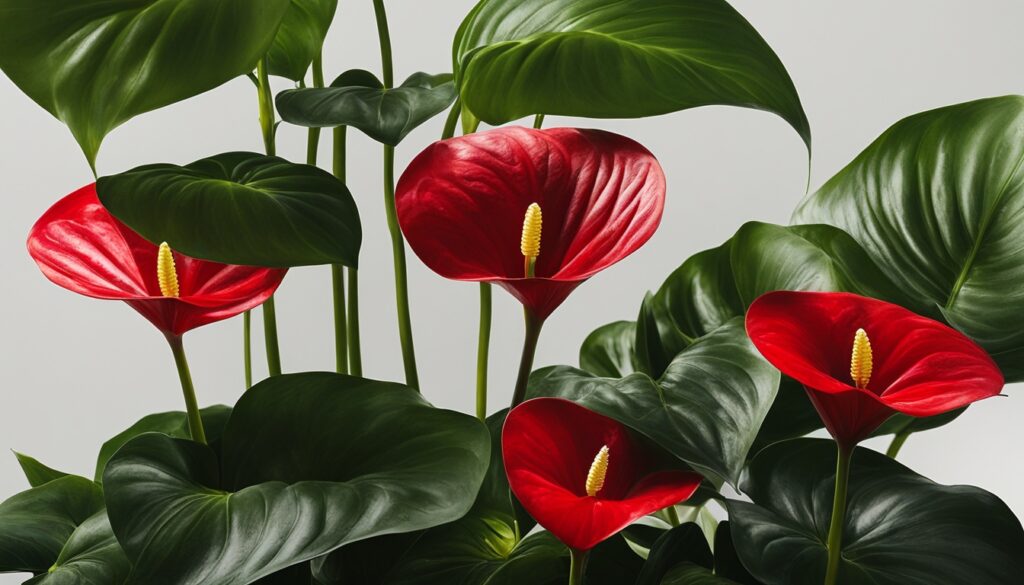
Humidity Problems
Keeping the right humidity is key for anthurium plants. These tropical plants do well in humid places. If the air is too dry, you might see leaves with brown edges or tips. This shows they’re stressed from the low humidity.
To help your anthurium, think about getting a humidifier or putting a tray of water with pebbles near it. The water will evaporate and make the air more humid. This keeps anthurium brown leaves away. Try to keep the humidity at 60% or higher for a healthy plant.
“The ideal humidity level for healthy growth of anthuriums is around 60% or above.”
Using a humidifier or water tray helps a lot. You can also put your anthurium with other plants. This makes the air more humid. Just make sure there’s enough air movement to avoid diseases that like damp, still air.
By taking care of the anthurium humidity needs, your plant will stay green and full. It will also bloom more, making it a favorite among plant lovers.
Pest Infestations
Anthuriums are known for their beautiful flowers and lush leaves. But, they can sometimes get pests. These pests can harm your plants if you don’t act fast. But, you can keep your anthurium plants healthy and pest-free with the right steps.
Spider mites are a common pest that target anthuriums. They can multiply fast and make leaves turn yellow and weak. Aphids also bother anthuriums by eating the plant’s sap. They leave behind a sticky stuff that attracts ants and other pests.
Mealybugs look like tiny cotton balls and can also harm anthuriums. They suck the plant’s juices, making leaves turn color and grow poorly. Checking your plants often can help you spot these pests early.
To control pests on anthuriums, use both natural and chemical methods. Start by cleaning the plant with insecticidal soap or neem oil to kill the pests. If the problem doesn’t go away, you might need to use stronger chemicals like insecticides made for indoor plants.
Preventing pests is the best way to keep anthuriums healthy. Watch your plants closely, make sure they have good growing conditions, and act fast if you see pests. This will help protect your anthurium plants.
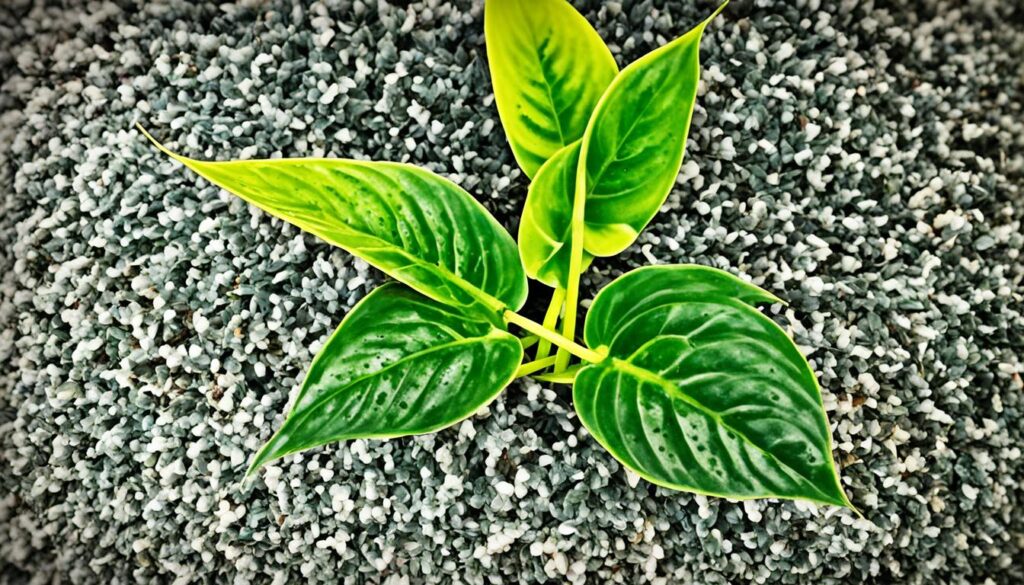
“The key to successful anthurium pest control is a proactive approach, combined with a variety of treatment methods to address different types of infestations.”
- Regularly check your anthurium plants for pests like webs, color changes, or sticky stuff.
- Use natural stuff like insecticidal soap or neem oil to get rid of pests.
- If pests don’t go away, use stronger chemicals like insecticides.
- Make sure your plants have the best growing conditions. Healthy plants are less likely to get pests.
- Act fast if you see pests to stop them from spreading to other plants.
By being careful and taking action, you can keep your anthurium plants safe from pests. This way, you can enjoy their beauty for a long time.
Yellowing and Browning Leaves
Anthuriums are known for their vibrant colors, but sometimes their leaves can turn yellow or brown. These issues can be fixed with proper care. Yellow leaves and browning spathes are common problems that can be solved.
Unraveling the Mystery of Yellowing Leaves
Yellow leaves on an anthurium can mean several things are wrong. Overwatering, underwatering, or nutrient deficiencies can cause this. Make sure your plant gets the right amount of water and nutrients to stay green and healthy.
Taming the Browning Spathes
Anthuriums are known for their colorful spathes, but they can turn brown as they age. Cutting off the browning spathes helps. This makes the plant focus on new growth.
Fixing anthurium yellow leaves, anthurium brown leaves, and nutrient deficiencies quickly keeps your anthurium looking great. It also helps with healthy growth.
“Maintaining the lush, vibrant appearance of your anthurium is all about striking the right balance in its care.”
Lack of Blooms
Many Anthurium plant owners struggle with their plants not blooming. If your Anthurium stops flowering, it might mean there’s a problem. But, you can often fix this with the right care.
Not getting enough light or not getting the right nutrients are the main reasons for this. Anthurium plants love bright, indirect light and need a special fertilizer to bloom well. Without enough sunlight or the right food, they might not make flowers.
- Make sure your Anthurium gets bright, indirect light for at least 6 hours a day.
- Feed it a special blooming fertilizer every 2-3 months when it’s growing.
- Water the plant only when the top inch of soil feels dry.
- Trim dead or damaged leaves to help the plant focus on growing and blooming.
With patience and the right care, your Anthurium should bloom again. Fixing the anthurium lack of blooms issue lets you enjoy its beautiful flowers for a long time.
“Anthuriums are known for their showy, long-lasting blooms, so when they stop flowering, it can be quite disappointing. But with a little troubleshooting, you can usually get them back on track.”
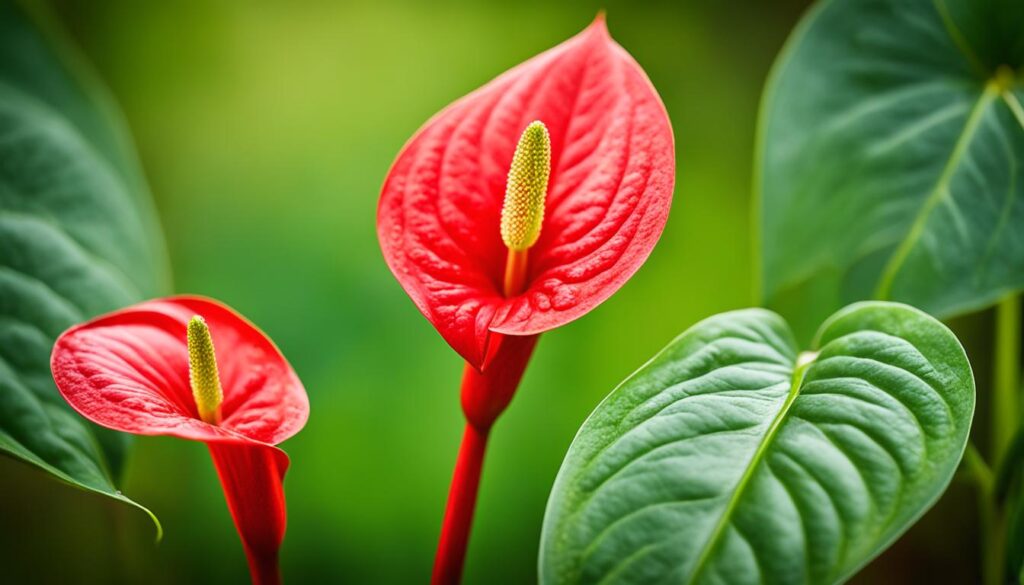
Being consistent is important for anthurium flowering. Give your plant the right conditions and care, and you’ll get lots of those beautiful, heart-shaped flowers. Anthuriums are a favorite for indoor and outdoor gardens because of their lovely blooms.
Bacterial Blight and Wilt
Anthuriums are loved for their bright flowers and lush leaves. But, they can face big problems from diseases like anthurium bacterial blight and anthurium bacterial wilt. These diseases can spread fast and harm your plants if not treated.
Battling Bacterial Blight
Anthurium bacterial blight is a common disease caused by Xanthomonas bacteria. It shows up as V-shaped, wet spots on the leaf edges. Studies say up to 30% of anthurium plants can get this disease.
Act fast if you see bacterial blight. Use clean tools and start with healthy plants. Also, keep your plants well-watered and well-ventilated to stop the disease.
Combating Bacterial Wilt
Anthurium bacterial wilt is another big threat, caused by Ralstonia bacteria. It moves through the plant and can kill it. In some places, up to 20% of anthurium plants get this wilt.
- Keep everything clean to stop bacterial wilt. Sterilize tools and use healthy plant material.
- Watch your plants for wilting or yellowing leaves. Catching it early helps you act fast.
- Put sick plants away from healthy ones to stop the disease from spreading.
Stay alert and follow expert advice to fight anthurium bacterial blight and anthurium bacterial wilt. This way, you can keep your anthurium plants healthy.
“Proactive disease prevention is the key to maintaining healthy, thriving anthurium plants in your garden or indoor space.”
Fungal Diseases
Anthurium plants face issues with anthurium fungal diseases besides bacterial and pest problems. Common issues include Rhizoctonia root rot and Phytophthora/Pythium.
Rhizoctonia Root Rot
Rhizoctonia root rot is a serious fungal disease. It targets the roots and lower stems of Anthurium plants. This fungus causes stems to become water-soaked and girdled, leading to wilting and possibly killing the plant.
Symptoms include stunted growth, yellowing leaves, and brown or reddish discoloration.
Phytophthora and Pythium
Phytophthora and Pythium are known as “water molds.” They can harm Anthuriums, causing wilting and yellowing leaves. These fungi do well in moist conditions. So, proper anthurium soil and watering practices are key to prevention.
To fight anthurium fungal diseases, use well-draining soil mixes. Avoid using contaminated materials for propagation. Also, use fungicides when needed. By being proactive, you can keep your Anthurium plants healthy.
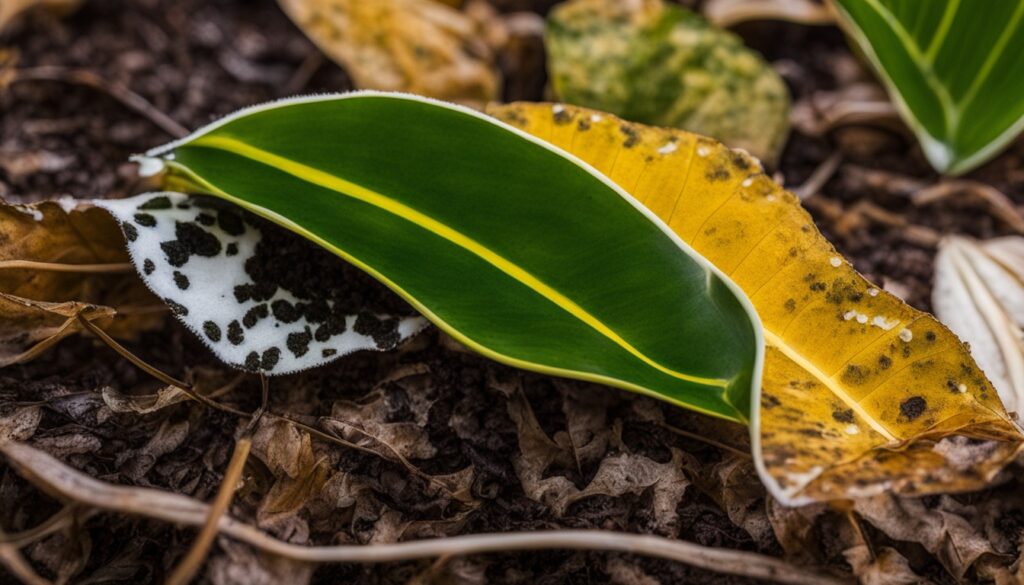
“Fungal diseases can be some of the most challenging problems for Anthurium growers, but with the right preventive measures and treatment, they can be effectively managed.”
Conclusion
Learning about anthurium care and common issues helps you keep these beautiful plants happy. By watching over them, giving them the right home, and acting fast when needed, you can enjoy their lovely leaves and flowers for many years.
Dealing with problems like too much water, not enough light, pests, or diseases can be tough. But, the tips in this guide can make fixing these issues easier. By taking good care of watering, soil, temperature, humidity, and feeding, you’ll make a great home for your anthuriums.
With some effort and care, anthuriums can bring a bit of tropical beauty inside. So, take on the challenge of caring for these plants and feel the joy of growing these beautiful, tough houseplants at home.



Can you be more specific about the content of your article? After reading it, I still have some doubts. Hope you can help me.